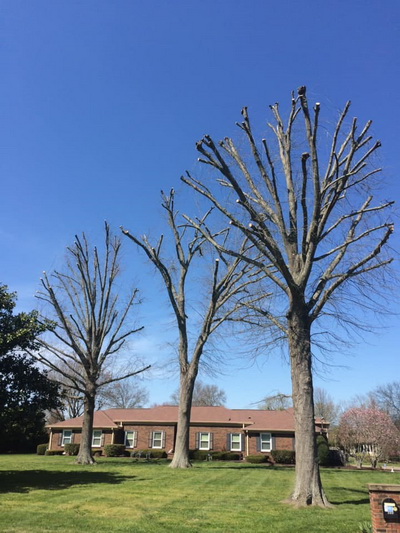Tree topping is a widespread phenomenon that afflicts some of Nashville’s urban trees (Figure 1). As an arborist, it is quite sad to see a tree become topped due to a lack of knowledge and understanding of basic tree biology. Since trees utilize their leaves to photosynthesize, I never understood why/how anyone could promote (or accept) tree topping as an approved arboricultural practice…
I believe a primary driving force behind tree topping is that people often think that the tree needs to be smaller, OR that by topping a tree, they can obtain some form of symmetry. Remember, nature is not symmetrical, and someone with a chainsaw should not be the one determining the growth habit (i.e., shape) of a tree.
_____
Tree topping is the arbitrary (and excessive) removal of tree branches above a certain height with no regard to tree health.

Figure 1: Mature Oak trees that have been destructively topped.
Tree topping has many undesired consequences:
- Tree topping destroys the balance between roots and shoots (i.e., the crown of the tree).
- By removing a large portion of the upper canopy, you create an imbalance between roots and shoots. Further, the immediate loss of the upper canopy (in one cutting) can ultimately lead to the death of roots, further impacting the tree.
- Tree topping can lead to sunscald of tree tissues.
- Following the immediate loss of large-diameter branches in the upper canopy, the location of the large (improper) pruning cuts now expose the limbs (and tissues) to constant and direct sunlight (Figure 2), which can lead to the development of large cankers along these nubs.
- Topped nubs left behind following topping never heal.
- By removing excessively-large limbs, the tree has little ability to compartmentalize (i.e., close) these improper pruning cuts. In turn, you will commonly see the ends of branches that have been topped quickly succumb to rot.
- New growth following topping is very weakly attached.
- While certain species of tree can/do re-sprout following topping, this new growth is simply and response to improper pruning. This new growth is weakly attached and develops very differently than a natural branch would typically form. In turn, during high winds, heavy rains, or ice buildup, these new, weakly-attached branches are more likely to shed from the tree.
- Tree topping actually increases the amount of foliage in a tree’s canopy.
- Commonly, I hear the complaint, “well, the tree was too tall (or large), so we had it topped”. This is unfortunately a myth of topping—to think that you can make a tree smaller. Once topped, all trees will immediately (try to) return to their full size. However, following topping, the tree now will have a much denser (and heavier) canopy than it had previously. Therefore, topping is only temporary, and must be continually completed—leading to a pricing structure that greatly exceeds the amount of having the tree properly pruned one time—correctly.
- Tree topping looks absolutely awful.
- Immediately after topping a tree, the obvious disfigurement becomes apparent (Figure 2), but as a Certified Arborist, I can tell if a tree has been topped from a mile away. Topped trees will never regain their former glory (or growth habit and structure). The old topped cuts will remain behind for decades on the tree and will always be visible to the trained eye.

Figure 2: Tree topping hurts trees and is aesthetically unappealing.
As a homeowner, it is perfectly fine to not understand tree physiology. However, it is not okay for a tree company to sell a service that is so obviously destructive (and has routinely been shown to have negative consequences for both the tree and your property aesthetics). Tree topping should NEVER be completed on ANY tree. If someone recommends topping a tree on your property, be very weary, consult with an ISA Certified Arborist, or just do a bit of research yourself—before accepting the bid. Keep in mind, too, that tree topping can be hidden behind the guise of terminology such as, “cut back”, “reduce the length”, “lower in height”, or simply “prune”. Ask for specifics about the work to be completed (in writing) before beginning any potential tree work.
At Community Tree Preservation, we strive to provide high quality work and show alternatives to tree topping when asked “will you top my tree.” While it is certainly clear that most tree installation companies do not account for the mature size of a tree, don’t fault the tree, and humble it by cutting it in half—arbitrarily. Instead, consider the list of long-term consequences described above. If a tree needs topping, this is a prime example of “the wrong tree in the wrong place”. Sometimes, removal (and replacement) is a much better option than slowly watching a disfigured, unnatural, and unhealthy tree struggle for the remainder of its life.

Recent Comments